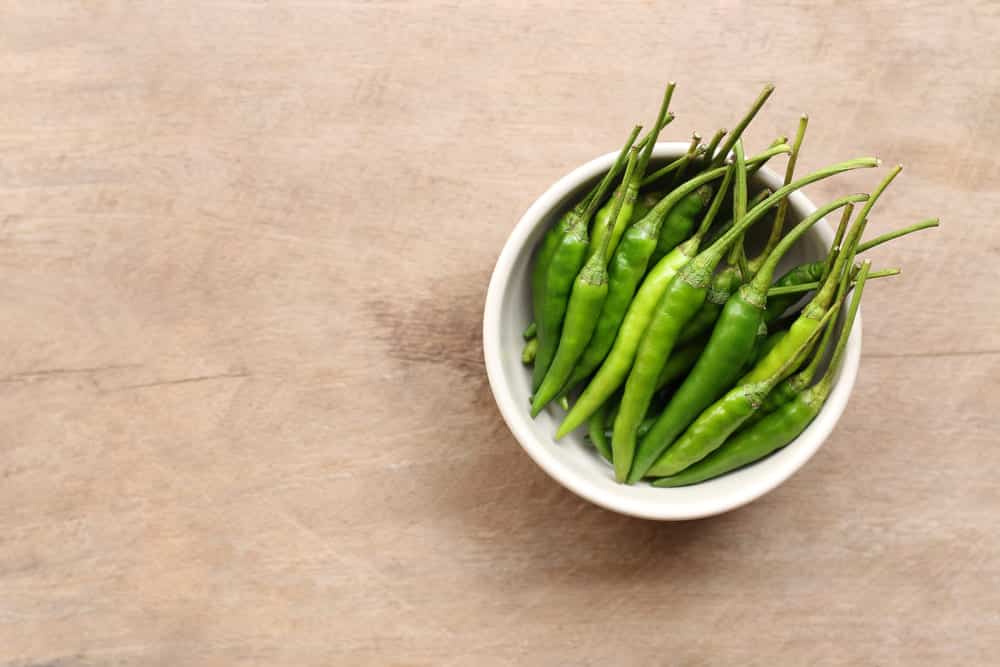
Green chili is an umbrella term that represents every single chili pepper that has a green color. Almost all types of chilies go through three color changes during the maturity process. Initially, chili peppers have a green color. If allowed to mature, the green color changes to red, and the red color ultimately changes to yellow or orange.
Most mild chilies are plucked when unripe, which is why green chilies are more common than red, yellow, or orange chilies. Green chilies are slightly-bitter and less spicy than its red, yellow, or orange counterparts.
What to do if you’re using a recipe that calls for using green chilies, but the store/supermarket is out of green chilies? Fear not, there are a plethora of chili types that can be used as a substitute for green chilies.
Substitution For Green Chilies
We have decided to substitute green chilies with red or yellow chilies. There are a lot of red and yellow chili varieties/groups. So for the sake of simplicity, we are going to discuss a few varieties that are used to create edible dishes.
Red chilies
Chilies that get a red color when fully matured consist of bird’s eye chilies, jalapeños, cayenne chilies, serrano peppers, bell peppers, and many more. Red chilies are slightly-hotter that their green counterparts. They are also less bitter than green chilies of the same variety/group.
1) Bird’s eye chilies
If you’re tired of eating mild, flavorless green chilies, and are looking for something that will burn your mouth, the bird’s eye chili aka Thai chili is a suitable alternative.
Thai chili is most-commonly grown in Ethiopia and Southeast Asia. But unlike its two birthplaces, the tongue-burning Thai chili is only found in Asian recipes. Vietnamese people use this chili to make salads, soups, and stir-fried dishes, whereas Thai people use it in their Thai-salads and Thai-curries.
Bird’s eye chilies are known for their spiciness (50,000 to 100,000 Scoville) and fruit taste. Its taste is further enhanced when the Thai chili is allowed to ripen into a bright red color.
2) Cayenne pepper
Unlike the extremely hot Thai chili, cayenne pepper is a moderately-hot chili that is used to flavor dishes.
Cayenne pepper belongs to Capsicum annum, a chili type that includes bell peppers, pimentos, jalapeños, etc. The chili is harvested after maturity, meaning the cayenne pepper found inside stores/supermarkets rarely has a green color.
Cayenne chili peppers are moderately-hot with a Scoville level equal to 30,000 to 50,000 Scoville.
3) Serrano pepper
Originated from the Mexican mountainous regions of Hidalgo and Puebla, the pepper is named serrano as a reference to the Sierras Mountains of Hidalgo and Puebla regions. Similar to Thai chilies, unripe serrano peppers are also green colored. But upon maturity, the color can change from green to red, brown, orange, or yellow.
The serrano peppers are slightly hotter than jalapeño peppers having a Scoville rating of 10,000 to 23,000 Scoville. The peppers are eaten raw or used in making salsa and pico de gallo.
Yellow chilies
Chilies that get a yellow color when fully-matured consist of Bolivian rainbow pepper, lemon drop pepper, aji Amarillo, aji charapita, prairie fire pepper, Hungarian wax pepper, and many more. Yellow chilies are slightly-hotter that their green counterparts. They are also slightly-tangy than green chilies of the same variety/group.
1) Hungarian wax pepper
Hungarian wax peppers are almost as hot as jalapeño peppers. The peppers have a banana-like shape and a tangy sweetness that comes from its natural ripening process. Since the peppers are not overly spicy, they’re great to start experimenting with spicy foods.
Hungarian wax peppers have a Scoville rating of 5000 to 10,000 Scoville.
2) Lemon drop pepper
Similar to the Hungarian wax pepper, the lemon drop pepper has a sweet-tangy taste. But unlike Hungarian wax pepper’s culinary use, the lemon drop pepper is often used as an ornamental pepper.
Lemon drop pepper has a spiciness level that matches with the serrano pepper. Some Lemon drop peppers can even reach the spiciness level of cayenne peppers.
Lemon drop peppers have a Scoville rating of 15,000 to 30,000 Scoville.
3) Bolivian rainbow pepper
A Bolivian rainbow pepper, when ripe, can have a yellow, red, orange, or purple color. Bolivian Rainbow peppers have a cone shape and a flavor profile similar to cayenne peppers.
Bolivian Rainbow peppers have a Scoville rating of 10,000 to 30,000 Scoville.